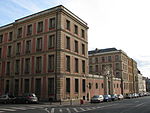Cemetery of Saint-Louis, Versailles

The Cemetery of Saint-Louis, Versailles (French: Cimetière Saint-Louis de Versailles) is one of several cemeteries in Versailles, Yvelines. It is among the oldest urban cemeteries in France, having been established in 1770 by the parish of Saint-Louis, Versailles, the church of which is now Versailles Cathedral. Although it may house fewer graves of well-known persons than the Cemetery of Notre-Dame, Versailles, it is nevertheless of significant interest for the artistic quality of many of the tombs and for the quantity of graves of aristocratic families and military officers based at the nearby Palace of Versailles. A small column against the wall marks the site of the common ditch where some 40 persons were buried, victims of the September Massacres on 9 September 1792. The massacre itself took place at the Quatre Bornes ("Four Milestones"), at the present crossroads between the Rue de Satory and the Rue d'Orléans. The victims had been transferred from the prison at Orléans, and were mostly former senior government officials, officers of the Royal army or refractory priests (among them the Bishop of Mende). Certain monuments are distinguished by their unusual workmanship, for example that of the naval lieutenant Édouard Villaret-Joyeuse (died in 1854 at Havana), which is in the form of a rostral column.
Excerpt from the Wikipedia article Cemetery of Saint-Louis, Versailles (License: CC BY-SA 3.0, Authors, Images).Cemetery of Saint-Louis, Versailles
Rue Monseigneur Gibier, Versailles
Geographical coordinates (GPS) Address Nearby Places Show on map
Geographical coordinates (GPS)
| Latitude | Longitude |
|---|---|
| N 48.7927 ° | E 2.1223 ° |
Address
Chapelle de l'Immaculée-Conception (Chapelle des Clarisses)
Rue Monseigneur Gibier
78000 Versailles, Saint-Louis
Ile-de-France, France
Open on Google Maps









